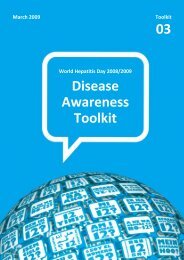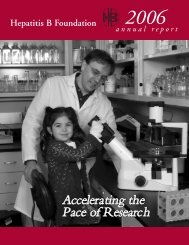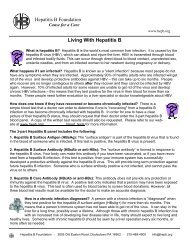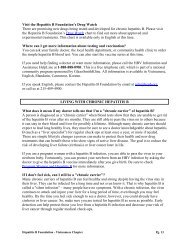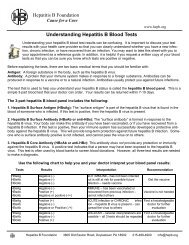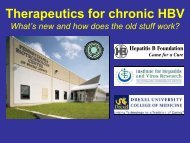Slide Presentation - Hepatitis B Foundation
Slide Presentation - Hepatitis B Foundation
Slide Presentation - Hepatitis B Foundation
Create successful ePaper yourself
Turn your PDF publications into a flip-book with our unique Google optimized e-Paper software.
Making Sense of <strong>Hepatitis</strong> BTreatment OptionsMack C. Mitchell, Jr., M.D.Director of GastroenterologyJohns Hopkins Bayview Med Center1
Relevant Disclosures• Bristol Myers Squibb– Advisory Board2
Questions to be addressed• What are the differences between acute andchronic diseases?• How does hepatitis B damage the liver and canthis knowledge inform our treatment strategies?• In 2009, who should be treated? With what?For how long?• What do we need to know about long-termtreatment?• How do we manage resistance to anti-viralmedications?3
What is the hepatitis B virusand how does someone getinfected?4
<strong>Hepatitis</strong> B Virus (HBV)• Hepadnaviridae primarily infects liver cells• 100 times more infective than HIV; muchhigher virus levels than HIV or hepatitis C• Found in blood and body fluids– Able to survive in dried blood for longerthan 1 weekOtt et al. J Pediatr Health Care. 1999;13(5):211-216.Ribeiro, et al. Microbes and Infection. 2002;4:829-835.MMWR. 2003;52:1-33.5
Transmission of HBVPerinatal transmissionHorizontal transmissionPerinatal• 90% ofinfectedinfantsbecomechronicallyinfectedMotherInfantHost• 6% ofpeopleinfected overthe age of 5becomechronicallyinfectedRecipientChild-to-childContaminated needlesSexual contactsHealthcare workerBlood transfusion6
What are the differencesbetween acute and chronicdiseases?7
Acute vs Chronic• Symptoms develop inhours to days• Toxins, injuries,infections• Antidotes, repair ofinjury, antibiotics, etc• Prevention throughvaccination, avoidinginjury, etc• Treatment is short-term• Symptoms developafter many years• Degenerative andchronic inflammatoryprocesses: cancer,arteriorsclerosis, aging,Alzheimer’s, arthritis,etc• Reduce risk factors forprogression to avoidend organ damage• Treatment is long-term8
Successful Prevention of Acute<strong>Hepatitis</strong> by VaccinationCases per 100,000 Popula1412108642VaccinelicensedHBsAg screeningof pregnantwomenrecommendedRecombinantVaccineDecline amongMSM & HCWsInfantImmunizationrecommendedOSHA Rule enactedAdolescentImmunizationrecommendedDecline amonginjectingdrug users01967 1970 1973 1976 1979 1982 1985 1988 1991 1994 1997 2000Source: NNDSSYear9
How does hepatitis Bdamage the liver?10
Pathophysiologic Cascade of CHB:Significance of HBV ReplicationHBV Replication(Measured bySerum HBV DNA)LiverInflammationALT ElevationWorsening Histology• Necroinflammation• Fibrosis• CirrhosisDiseaseProgression• Liver failure• Liver cancer• Transplant• DeathFrom http://www.fda.gov/ohrms/dockets/ac/05/slides/2005-4094S1_02_01-BMS-Entecavir_files/frame.htm#slide1504.htm. Accessed 09/20/06.11
HBV: Factors Associated With IncreasedRisks of Progression to CirrhosisHost FactorsOlder age*(longer duration)Male*Immune statusVirus FactorsHigh levels of HBVreplication*Genotype (C > B)*HBV variant(core promoter)EnvironmentalFactorsConcurrent infection(HCV*, HDV, HIV)Alcohol consumption*Diabetes mellitus †Obesity †*Supported by strong evidence.†Further studies needed.Yim JY, Lok AS-F. Hepatology. 2006;43:S173-S181.12
HBsAg as a Risk Factor for HCCRelative HCC risk based on HBsAg statusStatusHCCPopulationAt RiskIncidence per100,000/yrRelative Riskto HBsAg (-)No CirrhosisHBsAg (+) 1133,454(15.2%)528 217No cirrhosis 107 3,414 505 201Cirrhosis 6 40 2,419 961HBsAg (-) 3 19,253 3No cirrhosis 3 19,223 3Cirrhosis 0 30 0Beasley PR, Hwang L-Y. Viral <strong>Hepatitis</strong> and Liv Dis. 1984;209-224.13
HBVDNA and Natural HistoryIncidence of HCCIncidence of Cirrhosis% per year1.41.21.00.80.6HBV DNA (copies/ml)
Conclusions regarding liver injuryfrom <strong>Hepatitis</strong> B infection• Replication of hepatitis B virus stimulates animmune response that leads to inflammation• Inflammation damages liver tissue andstimulates the process of repair (fibrosis andcirrhosis)• Cirrhosis may lead to poor metabolic function ofliver cells• Tissue damage may also lead to uncontrolledgrowth of some cells that may lead to cancer15
Treatment of Chronic Diseases• Eliminate the cause• Reduce risk factors for development orprogression of disease• Treat the consequences andcomplications of end-organ damage• Replace the damaged organ or tissue16
Risk factors for arteriosclerosis andchronic heart disease• High blood pressure• High cholesterol• Diabetes• Cigarette smoking• Lack of exercise• Older age• Family history of heart disease17
Treatment of arteriosclerosis• Control blood pressure with medications(long term)• Lower cholesterol with medications (longterm)• Prevent/control diabetes with medicationsand diet• Increase exercise• Stop smoking18
Chronic Liver Diseases• Caused by toxins (alcohol), viruses,disordered immune response andinflammation, genetic factors, etc• Generally takes more than 10 years todevelop problems related to chronic liverdisease• In late stages, increased risk of internalbleeding, fluid retention, mental confusion19
Treatment ofChronic <strong>Hepatitis</strong> BReducing the amount of hepatitisB virus to very low levels allowsliver cells to recover. Alltreatments work in this manner.CONFIDENTIAL: FOR BMS CONSULTANT PURPOSES ONLY20
Chronic <strong>Hepatitis</strong> BGoals of Treatment• Long Term Goals• Prevention of cirrhosis and liver cancer• Sustained suppression of HBV replication• Similar goals for both E positive and negative CHB• Treatment end points:• Normalization of serum ALT level• Undetectable serum HBV DNA• Loss of HBeAg (if present)• Improvement in liver cell appearance and structureLok AS, McMahon BJ. Hepatology. 2001;34:1225-1241.21
Important new information on treatmentof hepatitis B in last 12 months• NIH consensus conference identified at riskpopulation and those in need of treatment aswell as approaches to therapy• AASLD, EASL, APASL all agree that 1 st linetreatment should be highly potent drugs with lowrisk of resistance• Tenofovir (Viread) approved for treatment ofchronic hepatitis B infection• Five year safety data on entecavir (Baraclude)showed long term viral suppression with minimalresistance and no significant side effects22
NIH Consensus Conference on HBVNeed for Long-term Studies• “…no conclusive evidence from RCTs of anti-HBVtherapy has demonstrated a beneficial impact on …clinical outcomes because cirrhosis, HCC anddeath do not occur for many years after infection …and would therefore require long-term evaluation oftherapy to demonstrate benefit.” 1• RCTs were underpowered to determine clinicaloutcomes. 21Sorrell MF, et al. Ann Int Med 2009;150:104-110.2Shamiliyan TA, et al. Ann Int Med 2009;150:111-124.23
Proof of PrincipleAnti-viral therapy is effective inpreventing complications associatedwith chronic hepatitis B infection24
Anti-viral therapy for Patients with CHB andAdvanced Liver Disease:Effect on Disease Progression*25Patients with diseaseprogression (%)2015105Placebo (n= 215)LVD (n= 436)n=198P=0.001n=173n=385PlaceboLamivudine21%n=439%n=1220n=4170 61218243036Time to disease progression (months)* ≥2-pt ↑ CP score or major eventLiaw Y-F et al. N Engl J Med 2004;351:1521-1531.25
Effect of Anti-viral Therapy on Incidenceof HCC in Patients with Advanced FibrosisDiagnosis of HCC (%)10PlaceboPlacebo (n= 215)LVD (n= 436)Lamivudine00 6 12 18 24 30 367.4%P = .0473.9%Time to diagnosis of HCC (months)Liaw YF, et al. N Engl J Med 2004;351:1521-1531.26
Who Should be Treated?• HBV carriers with active necroinflammatorydisease and elevated HBV DNA should betreated• All HBV carriers with active viral replication arepotential treatment candidates– Changes in HBV replication status and/oractivity/stage of liver disease– Development of more effective treatments• Not a question of whom to treat but when totreat27
NIH Consensus Conference on HBVGuidelines for Therapy• Therapy is indicated– Cirrhosis, both compensated and decompensated• Therapy may be indicated– Immune active phase (HBeAg +), particularly overage 30– Reactivation phase (HBeAg -) with high DNA andelevated ALT• Immediate therapy not routinely indicated– Inactive carriers and low replicative phase (lowDNA, normal ALT, minimal inflammation/fibrosis)Sorrell MF, et al. Ann Int Med 2009;150:104-110.28
FDA Approved Therapies for Chronic HBVGeneric Name Trade Name ManufacturerInterferon alfa-2b,recombinantINTRON ® AInterferonsScheringCorporationPeginterferon alfa-2a PEGASYS ® RocheLaboratoriesLamivudineNucleosides/NucleotidesDate Approvedfor <strong>Hepatitis</strong> B19922005EPIVIR-HBV ® GlaxoSmithKline 1998Adefovir dipivoxilHEPSERA Gilead Sciences 2002Entecavir BARACLUDE Bristol-MyersSquibb2005TelbivudineTYZEKAIdenix andNovartis2006Tenofovir VIREAD Gilead Sciences 200829
Interferon-alfa: Use in theTreatment of Chronic <strong>Hepatitis</strong> BPros• Short course (16-32 wks)• 39% - 54% HBeAg loss• HBsAg lost in 27 – 35%of responding patientswho lose e antigenCons• Significant side effects• Dangerous in cirrhosis;contraindicated indecompensated patients• Drug-resistant mutantshave not been described30
Nucleos(t)ide Analogues: Use in theTreatment of Chronic <strong>Hepatitis</strong> BPros• Oral administration• Minimal side effects• Useful in decompensatedcirrhosis and after livertransplant• Comparable e antigenloss over course oftreatmentCons• Long duration of treatment(>1 yr, most likely many)• Drug-resistant mutants,particularly with LAM,telbivudine, adefovir• HBsAg loss is lesscommon, but does occur31
Treatment ofHBeAg(+) Patients32
Lack of Detectable HBV DNA afterOne Year of Therapy for HBeAg(+) CHBNot Head to Head Trials, Different Patient Populations and Trial Designs33Peg-IFNLamivudineEmtricabineTelbivudineEntecavirAdefovir10080604020076%67%60%39% 39%25%21%Loss of Detectable HBV DNA (%)Tenofovir
Normalization of ALT after OneYear of Therapy for HBeAg(+) CHBNot Head to Head Trials, Different Patient Populations and Trial Designs100Normal ALT (%)8060402039%66% 65%77%68%48%21%0Peg-IFNLamivudineEmtricabineTelbivudineEntecavirAdefovirPlaceboHoofnagle JH et al. Hepatology 2007;45:1056-1075.34
HBeAg Seroconversion DuringContinued TreatmentNot Head to Head Trials, Different Patient Populations and Trial Designs% of Patients6040200Lamivudine40%29%22%47% 50%1 2 3 4 5Years of Therapy6040200Adefovir24%12%1234Years of Therapy48%560Entecavir60Tenofovir402021%31%37%402021%28%0102 3 4 5 1 2 3 4 5Years of TherapyYears of Therapy1. Chang T-T et al. J Gastro Hepatol 2004;19:1276-1282.2. Lok ASF, Gastro 2003; 125:1714-17223. Chang TT et al. NEJM 2006; 354:1001-10104. Chang TT et al. Hepatology 2006;44(Suppl 1):229A.5. Marcellin P et al. N Engl J Med 2003; 348:808-8166. Marcellin P et al. Hepatology 2006; 44 (Suppl 1):548A7. Lai CL et al, Hepatology 2005, 42 (Suppl 1):748A8. Lai C-L et al. Hepatology 2006;44(Suppl 1):222A.35
Treatment ofHBeAg(-) Patients36
Lack of Detectable HBV DNA afterOne Year of Therapy for HBeAg(-) CHB37Peg-IFNLamivudineEmtricabineTelbivudineEntecavirAdefovir10080604020072%63%88%90%79%51%2%Loss of Detectable HBV DNA (%)PlaceboHoofnagle JH et al. Hepatology 2007;45:1056-1075.
Normalization of ALT after OneYear of Therapy for HBeAg(-) CHB381008074%74%78%72%65%6038%4024%20Normal ALT (%)0Peg-IFNLamivudineEmtricabineTelbivudineEntecavirAdefovirPlaceboHoofnagle JH et al. Hepatology 2007;45:1056-1075.
How long should patientsbe treated?If there is a clear relationship between level ofvirus and risk of long term complications,indefinite long-term treatment may be betterthan stopping after achieving an arbitraryendpoint, such as e antigen loss.39
The Problem of Nucleos(t)ideResistance in Chronic <strong>Hepatitis</strong> B40
Consequences of AntiviralResistance• Loss of initial virologic, biochemical andhistological response• <strong>Hepatitis</strong> flares, hepatic decompensation anddeath• Limit future treatment options• Transmission to treatment-naïve persons posesa potential public health problem41
Factors Associated With Achieving aLong-Term Response to CHB TherapyViralFactorsPatientFactorsLong-TermResponsePawlotsky JM. <strong>Hepatitis</strong> virus resistance. In:Antimicrobial Resistance and Implications for theTwenty-First Century. 2008.Locarnini S et al. Antiviral Therapy. 2004; 9:679–693.Drug Factors42
More potent drugs reduce theopportunity for resistance to develop120%100%80%60%40%20%0%6 mos 12 mos 18 mos 24 mosTimePotent drug Weaker drug43
Drugs with high genetic barrierreduce the opportunity forresistance to develop44
Genetic Barrier: Number of MutationsRequired for Drug ResistanceWild type HBVResistant HBV1 Genetic Mutation RequiredLuber AD. Med Gen Med. 2005. 7(3);69-80.45
Genetic Barrier: Number of MutationsRequired for Drug ResistanceWild type HBVResistant HBV3 Genetic Mutations RequiredLuber AD. Med Gen Med. 2005. 7(3);69-80.46
Combination vs. Single Drug Therapy forChronic <strong>Hepatitis</strong> B• Combining two drugs can increase the barrier toresistance IF the resistance profiles are different• Although combining drugs could theoreticallyincrease potency, so far, the potency ofcombination therapy is not better• The ideal combination has not yet been found• Some drugs such as entecavir (Baraclude) havehigh inherent genetic barrier to resistance47
Time to Disease Progression byYMDD Status2520Placebo (n=215)YMDDm (n=209) (49%)Wild Type (n=221)Placebo21%% withdiseaseprogression1510YMDDm13%500 6 12 18 24 30 36Time after randomisation (months)WT5%Liaw et al. New Engl J Med 2004: 351: 1521-1531.48
Increased Resistance with Long-termTreatment in Nucleoside-naïve PatientsPatientswithResistance(%)8060402070%65%53%42%24%11%18%29%22%Year 1Year 2Year 3Year 4Year 503%4%0.4% .3% 1% 1% 1Lamivudine 1 Adefovir 2 Entecavir 3,4,5 Telbivudine 6,71. Lok ASF et al. Gastroenterology 2003;125:1714-1722.2. Hadziyqnnis SJ et al. Gastroenterology 2006;131:1743-1752.3. Colonno RJ et al. Hepatology 2006;44:1656-1665.4. Colonno et al, Hepatology 2006, 44 (Suppl 1):229A5. Colonno RJ et al. J Hepatol. 2007;46(Suppl 1):S294.6. Tyzeka package insert7. Lai CL, Hepatology 2006;44(Suppl 1):222A.49
Avoiding Antiviral Drug Resistance• Drugs that require more than one mutation within thevirus to develop resistance have a “high geneticbarrier” to resistance (e.g. entecavir)• More potent drugs decrease the viral load rapidly,allowing less chance for resistance to develop• Avoid using drugs that are less potent and have alow genetic barrier• Combination therapy may be needed in those withresistance or a suboptimal initial response• Take medications regularly as prescribed, too littledrug may lead to resistance50
Non-pharmacologicalrecommendations for chronic HBV• Good diet, high in fruits and vegetables• Don’t smoke• Drink alcohol ONLY on special occasions, lessthan once weekly, never more than 2 drinks• Have HBV virus levels checked 2-3 times/year• Have ALT level checked 2-3 times/year• Have ultrasound surveillance for liver cancerannually if over age 35-4051
Summary• Chronic hepatitis B is a potentially serious problemwhich is increasing in frequency in the U.S.• Adverse outcomes result from active viral replicationleading to cirrhosis and liver cancer• Treatment options have improved significantly in thelast few years and now offer hope for prevention ofcirrhosis and HCC• The new model for treatment should recognize thathepatitis B is a chronic disease that potentiallyrequires long term suppression of viral replication52
Thank you to the <strong>Hepatitis</strong> B<strong>Foundation</strong> for all their goodwork53
Interpretation of Serologies for<strong>Hepatitis</strong> B• HBsAg indicates virus in serum• HBeAg indicates active replication ofwild type virus• HBV DNA quantifies virus in serum• HBsAb indicates protection againstfuture infection• HBcAb indicates past or presentinfection54
Surveillance for HCCAASLD Guidelines• Surveillance recommended for thefollowing groups with chronic HBV:– Asian men over age 40– Asian women over age 50– African men and women over age 20– All patients with cirrhosis– Anyone with family history of HCC55
Surveillance for HCCUse of AFP• A cutoff level of 20 ng/ml, provides theoptimum balance between sensitivity andspecificity• At this level, the sensitivity is only 60%• If the prevalence is 5% in the screeningpopulation, the PPV is only 41.5%!• Therefore, AFP alone is inadequate56
Surveillance for HCCUse of Ultrasound• Sensitivity 65-80% for detecting lesions>1cm• Specificity is approximately 90% whenapplied to surveillance population• Detection of lesions < 2 cm in cirrhosisrequires confirmation by other modalities,preferably 3 phase CT or MRI examiningarterial phase hypervascularity• Limitation: operator dependent57
NIH Consensus Conference on HBVControversies raised by systematic review• Role of intermediate markers such as HBV DNA andliver histology as surrogate measures for predictinglong-term clinical outcomes has not been adequatelytested• There is marked heterogeneity in study samples andmeasured outcomes, including methodology for HBVDNA• Potentially inappropriate focus on assessing benefits 6months after active treatment, since optimum durationof treatment is unknownShamiliyan TA, et al. Ann Int Med 2009;150:111-124.58
Why are we more concernedabout hepatitis B today?59
Global Impact of <strong>Hepatitis</strong> B2 billion with past/presentHBV infection15-40% develop cirrhosis,liver failure or HCCWorld population6 billionJ Hepatology. 2003;38:S90-S103.Lee. N Engl J Med. 1997;337:1733-1745.Lok. N Engl J Med. 2002;346:1682-1683.350–400 million withchronic hepatitis B~1 million/year die from HBV-associated liver disease60
Geographic Prevalence of Chronic <strong>Hepatitis</strong> BMay Be Impacted by Migration~2 million Asians~400,000South Americans~930, 000EuropeansHBsAg Prevalence≥8% - High2-7% - Intermediate
Genetic Barrier: Number of MutationsRequired for Drug ResistanceWild type HBVResistant HBV2 Genetic Mutations RequiredLuber AD. Med Gen Med. 2005. 7(3);69-80.62



